
Manufacturer's Specifications:
FM Tuner Section
Usable Sensitivity: Mono, 10.3 dBf; stereo, 17.2 dBf.
50-dB Quieting Sensitivity: Mono, 16.1 dBf; stereo, 36.1 dBf.
Frequency Response: 30 Hz to 15 kHz, + 0.5,-1.0 dB.
Output Voltage: 0 to 1.0 V rms.
S/N: Mono, 85 dB; stereo, 77 dB.
THD in Wide I.f. Mode: Mono, 0.03%, stereo, 0.07%.
Separation: Wide i.f. mode, 45 dB at 1 kHz, 33 dB from 70 Hz to 10 kHz.
Muting Level: 17.2 dBf.
Capture Ratio: Wide i.f. mode, 1.3 dB.
Image Rejection: 100 dB.
Alternate-Channel Selectivity:
Narrow i.f. mode, 80 dB.
I.f. Rejection: 100 dB.
AM Suppression: 55 dB.
AM Tuner Section
Usable Sensitivity: 25 uV.
S N: 40 dB.
THD: 0.7%.
Output Voltage: 0 to 300 mV.
I.f. Rejection: 40 dB.
Image Rejection: 40 dB.
General Specifications:
Power Requirements: 120 V a.c., 60 Hz.
Dimensions: 17 1/4 in. W x 3 3/8 in. H x 14 1/6 in. D (43.5 cm x 9.2 cm x 36.6 cm).
Weight: 9.3 lbs. (4.2 kg).
Price: $449.95.
Company Address: 200 Williams Dr., Ramsey, N.J. 07446.
I have always been a fan of Onkyo tuner designs. The company's T-9090 tuner, both in its original form and in its Mark II update, represents the best of what is possible, given today's somewhat antiquated FM broadcast standards. I fully expected that this lower priced Onkyo tuner would prove to be a worthy successor to Onkyo's earlier Model 1-4087, which it replaces. In many ways, it was, but I must report that in some details my sample did not fully measure up to published specifications. That's not to say that the tuner is a poor performer; it's just that I expected the front-end of this tuner to be more sensitive than my measurements indicated. More about all of this later. First, a review of the T-4700's circuitry and convenience features.
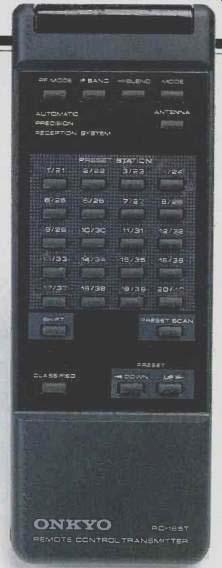
Circuitry includes a seven-varactor, MOS-FET front-end, an i.f. strip that uses up to five ceramic filters (in its narrow tuning mode), dual antenna inputs, FM tuning adjustable in 25- or 50-kHz increments (useful if your cable TV company supplies FM at nonstandard frequencies within the FM band), and a new power-supply configuration that improves sound quality, provides greater interstage isolation, and reduces residual noise by providing single-point grounding and parallel connections to all circuit blocks.
Onkyo's four-mode APR system (the acronym stands for Automatic Precision Reception) constantly monitors signal quality and automatically chooses the best settings for stereo/mono, high blend on or off, wide or narrow i.f. response, and local- or distant-reception sensitivity. All of these "decisions" can be overridden manually if desired. The tuner has 40 station presets, and preset memory retention does not require batteries (it is maintained by charged capacitors). Furthermore, when power is turned off, the last tuned-to station frequency will be accessed when power is turned on again.
Each of the 40 preset stations can be assigned to one or more separate categories for convenient access. Categories may be designated by broadcast content (classical, jazz, rock, etc.) or by any other notation, such as the name of a household member who listens to that format. An alphanumeric identifier can be programmed into memory (along with the broadcast frequency) and displayed to make station choices easier. Nearly all of the functions and convenience features of the T-4700, with the exception of output level adjustment, can be controlled by a supplied infrared remote control.
Control Layout
The power pushbutton for this tuner is at the lower left of the front panel. Much of the upper area of the panel is given over to a display area. The left half of the display shows whether APR is activated and what its current settings are, which of the two antenna inputs is selected, and whether tuning is currently automatic or manual. The right section of the display shows tuned frequencies or alphanumeric characters, stereo indication, signal strength, memory classification, preset station number, and tuning level. Tuning level refers to a choice of muting threshold, which can be set at either 27 dBf or 37 dBf depending upon local reception conditions.
A row of narrow buttons just beneath the display area consists of a "Tuning Level" selector, a "Display" selector button, "Up" and "Down" buttons for tuning or character selection, "AM" and "FM" band switches, and a "Cable/ Mute" button. This last one had me puzzled until I discovered that the only way to defeat this tuner's muting circuitry was to set it to tune in 25-kHz steps ("Cable") rather than in steps of 50 kHz. This is mentioned in the owner's manual only in connection with a paragraph on more precise tuning.
Further down below the left section of the display are pushbuttons to select antenna input, APR on/off, r.f. mode (local or distant), i.f. bandwidth, high blend on/off, mono or auto stereo, and tuning mode (automatic or manual). To the right of these are six larger buttons for preset-station classification assignment. In the panel's top right corner are 20 pushbuttons which are used for setting and accessing pre set stations. A "Preset Shift" button doubles the number of presets available. A "Preset Scan" button, a "Memory" button, and a small "Output Level" control knob complete the front panel's layout.
The rear panel of the T-4700 tuner is equipped with two coaxial, 75-ohm, FM antenna connectors; AM antenna terminals (to which a supplied AM loop antenna can be connected); left and right audio output jacks, and a pair of remote-control jacks intended for connection of other Onkyo components. A pair of 75/300-ohm transformers is supplied for those who might want to use 300-ohm ribbon antenna lead-in cable.
Measurements
Figure 1 shows the frequency response of the FM tuner section, which was down 1.22 dB at 15 kHz. Figure 2 is my usual plot of S/N, or quieting, as a function of FM signal strength. From Fig. 2, I am able to report that 50-dB quieting in mono required 24 dBf (as opposed to 16.1 dBf claimed by Onkyo); in stereo, 50-dB quieting took nearly 45 dBf worth of input signal, much more than the 36.1 dB claimed by the manufacturer. What was impressive, however, was the ultimate signal-to-noise ratio reached with strong signal inputs. It measured 83 dB in mono (a bit short of the claimed 85 dB, but still an excellent number) and about 70 dB in stereo. When signal strength was increased beyond the standard 65 dBf, to around 80 dBf, S/N in stereo continued to improve until I obtained a reading of 78.5 dB. I made these measurements for both the wide and narrow settings of the i.f. circuits but found little difference between the two sets of readings.
Such was not the case, naturally, when I plotted THD + N versus frequency (Fig. 3). In the wide i.f. mode, mono and stereo THD + N at 1 kHz was quite good, 0.029% for mono and 0.085% for stereo. At 6 kHz, THD + N measured a mere 0.02% in mono and 0.092% in stereo. When the tests were repeated using the narrow i.f. mode, stereo THD + N increased markedly, now measuring over 1.7% at 1 kHz, nearly 1.5% at 100 Hz, and just over 1% at 6 kHz. Mono THD + N remained low at 100 Hz (only 0.038%) but rose to 0.23% at 1 kHz and to 0.47% at 6 kHz.
Using a constant 1-kHz modulating signal, I next measured THD + N as a function of signal strength (Fig. 4), first using the wide i.f. setting and following up with the narrow i.f. measurements. Fairly good correlation was obtained between these readings at strong signal levels and those obtained in Fig. 3. The two sets of curves in Fig. 4 also enabled me to establish the least usable sensitivity figures for this tuner. Here, best results were obtained in the narrow i.f. mode, where usable sensitivity measured 20 dBf in mono and 14 dBf in stereo, as against the 10.3 dBf in mono and 17.2 dBf in stereo claimed by Onkyo.
Figure 5 shows how separation varied with frequency. The two dashed curves represent separation results (referred to the upper, solid traces) for the wide i.f. mode (upper solid curve and lower dashed curve) and for the narrow i.f. mode (lower solid curve used as reference to upper dashed curve). At 1.2 kHz (the closest data point to 1 kHz that the test system captured), a numeric readout showed that the modulated channel was within-0.1 dB of reference level and that separation was 49.33 dB below reference level. (Or, if you want to be as precise as my Audio Precision test gear, separation was therefore 49.23 dB at 1.24883 kHz!) At 10 kHz, separation was still a very impressive 41.3 dB, while at 100 Hz it remained as high as 46.5 dB. When the narrow i.f. mode was selected, separation decreased, as I would have expected, but still measured better than 35 dB at mid-frequencies.
My upgraded Audio Precision test gear now serves as a sophisticated spectrum analyzer, using Fast Fourier Trans form (FFT) operation and digital signal processing. My gear enabled me to plot a narrow-band spectrum analysis of a 5-kHz signal modulating one channel (Fig. 6A), while in a second trace (Fig. 6B), spectrum analysis revealed the crosstalk component appearing in the unmodulated channel output. The tall spike reaching 0 dB in Fig. 6A represents the desired 5-kHz signal, while the shorter spike at that frequency in Fig. 6B reveals that separation at 5 kHz was -43.78 dB. Other spurious distortion and crosstalk components can be seen at higher frequencies. Residual 19-kHz pilot carrier was down some 62 dB. Also visible are the sidebands of the 38-kHz subcarrier that are used to convey the L- R difference signals in a stereo multiplex tuner. These appear at 33 and 43 kHz (38 kHz, ±5 kHz).
Capture ratio in the wide mode measured 1.3 dB, as claimed. Alternate-channel selectivity in the narrow mode was 82 dB; in the wide mode it decreased, as expected, to around 58 dB. AM suppression measured 56 dB, while the results for i.f. rejection and image rejection were both in excess of 100 dB.
Figure 7 shows the frequency response of the AM tuner section of the T-4700. Response was down-6 dB at 3.0 kHz, and it was also off by the same amount at 60 Hz. Total harmonic distortion for 30% modulation of the AM signal was 0.73%, close enough to the 0.7% claimed by Onkyo.

Fig. 1-Frequency response, FM section.
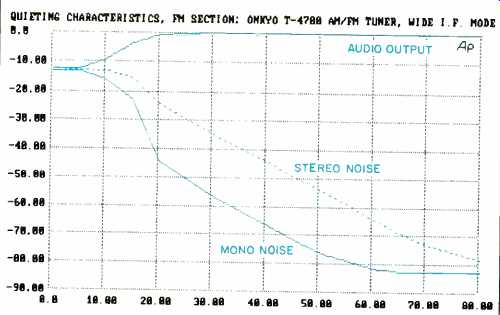
Fig. 2--FM quieting characteristics.
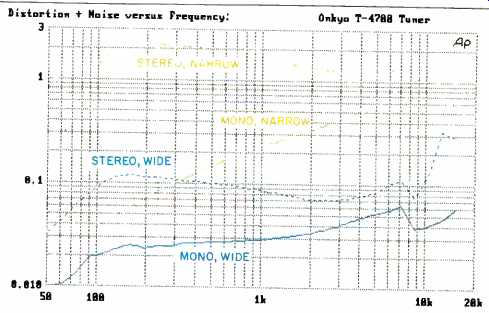
Fig. 3--THD + N vs. frequency.
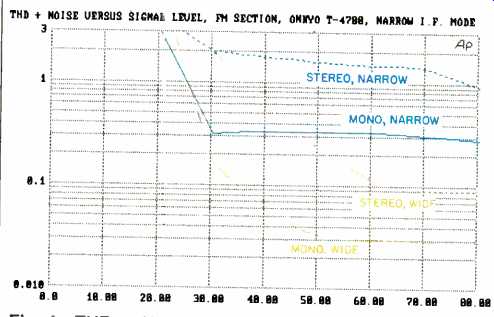
Fig. 4--THD + N vs. r.f. input signal level.
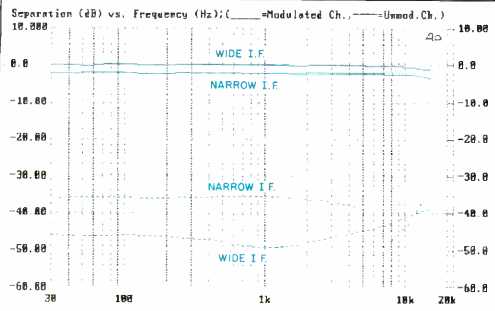
Fig. 5--Frequency response and stereo separation.
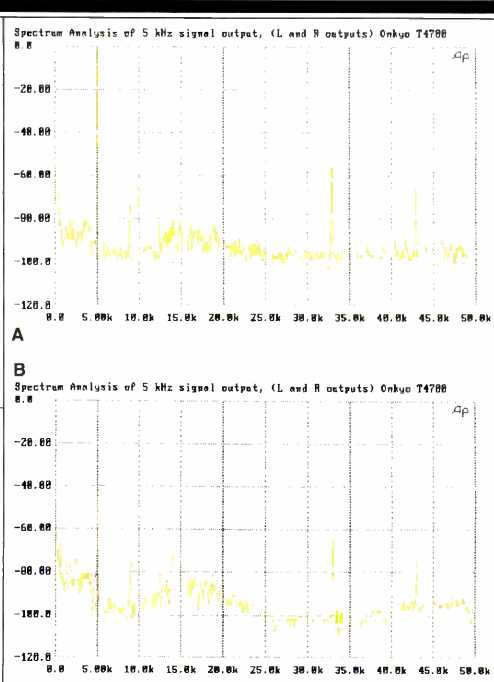
Fig. 6--Spectrum analysis of channel modulated by 5-kHz signal (A) and unmodulated
channel (B), showing crosstalk products.
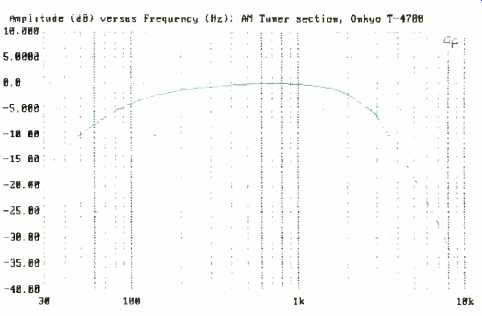
Fig. 7--AM frequency response.
Use and Listening Tests
I had no problems with the way this tuner functioned and sounded or the way it made its decisions concerning wide/ narrow i.f., high blend on or off, distant or local r.f. settings, or automatic mono/stereo switching. All of these aspects of Onkyo's APR system worked perfectly--I couldn't have made the selections any better myself, though I was pleased that I could override the APR decision if I chose to do so. What bothered me was the rather poor sensitivity figures obtained in mono for both wide-band and narrow-band i.f. settings.
For all of that, however, the 46 station signals that I did pull in when the tuner was connected to my outdoor antenna (40 of them in acceptably noise-free stereo) were reproduced with excellent sound quality and inaudibly low distortion. I needed to use the narrow mode for only two of those stations, which happened to be at frequencies only one channel away from powerful local stations in my area. The narrow mode eliminated the interference from stronger signals, as it was supposed to do.
The elegant automatic APR features of this tuner will appeal to the FM listener who simply wants the best possible reception of all incoming FM signals, even if that means occasionally giving up some separation or tolerating an increase in distortion. Being able to defeat APR also enables the more serious FM listener to decide which settings are preferable. If the sensitivity had been a bit better, the Onkyo Integra T-4700 would have earned highest marks from this FM fan. As it is, it comes close by being a superb value in its price class.
-Leonard Feldman
(Source: Audio magazine, June 1990)
Also see:
Onyko T-9090 Tuner (Equip. Profile, May 1985)
Onkyo T-9090II FM Tuner (Equip. Profile, Jul. 1988)
Onkyo Model A-7 Integrated Amplifier (Jan. 1978)
Onkyo DX-G10 Compact Disc Player (Mar. 1989)
Optonica ST-3636 AM/FM Stereo Tuner (Dec. 1978)
= = = =